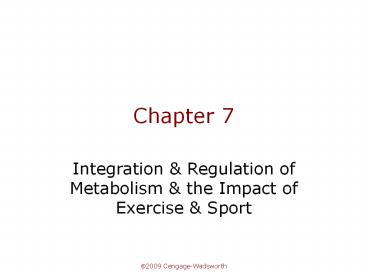Integration - PowerPoint PPT Presentation
Title:
Integration
Description:
Chapter 7 Integration & Regulation of Metabolism & the Impact of Exercise & Sport Interrelationship of Carbohydrate, Lipid, & Protein Metabolism Any energy nutrient ... – PowerPoint PPT presentation
Number of Views:222
Avg rating:3.0/5.0
Title: Integration
1
Chapter 7
- Integration Regulation of Metabolism the
Impact of Exercise Sport
2
Interrelationship of Carbohydrate, Lipid,
Protein Metabolism
- Any energy nutrient can fuel the body in the
short term - TCA cycle amphibolic pathway
- Lipogenesis
- CHO spares lipolysis - promotes gain
- Glucose is precursor for glycerol fatty acids
3
Interrelationship of Carbohydrate, Lipid,
Protein Metabolism
- Gluconeogenesis
- Glycerol portion only from fat
- Fatty acids with odd of C atoms
- Glucogenic amino acids
- Conversion among energy nutrients favors
lipogenesis
4
Interrelationship of Carbohydrate, Lipid,
Protein Metabolism
- TCA cycle electron transport chain - common to
all 3 - This catabolic pathway also
- Produces CO2 for carboxylation C for other
needs - Provides common intermediates
- Provides citrate malate for lipogenesis
5
The Central Role of the Liver in Metabolism
- Key processor distributor
- Glycogenesis glycogenolysis
- Protein synthesis, catabolism, conversion to
other compounds - Lipoprotein synthesis
6
Tissue-Specific Metabolism during the Fed-Fast
Cycle
- Stages of fed-fast cycle
- Fed state - lasts 3 hours after meal ingestion
- Postabsorptive/early fasting state - 3 to 12-18
hours after meal - Fasting state - 18 hours to 2 days after meal
when nothing else eaten - Starvation/long-term fast - fully adapted to
deprivation (weeks)
7
Carbohydrate Lipid Metabolism
- The fed state
- Glucose ? glycogen fatty acids
- Glucose used by nervous tissues, RBCs, adipose
muscle tissues - The postabsorptive or early fasting state
- Glycogenolysis
- Gluconeogenesis
8
Carbohydrate Lipid Metabolism
- The fasting state
- Amino acids (primarily), glycerol, lactate used
for gluconeogenesis - Ketone formation
- The starvation state
- Fatty acids used to greater extent
- Glycerol major glucose source
- Ketosis after oxaloacetate depletion
9
Amino Acid Metabolism
- Fed state - used for proteins or degraded
- Fasting
- Catabolism for energy produces quantities of N
- Excreted in urea
- Gluconeogensis in liver kidneys
10
System Integration Homeostasis
- Major regulatory systems
- Nervous system
- Endocrine system
- Vascular system
- Endocrine function in fed state
- GIP, CCK, gastrin, secretin
- Insulin
11
System Integration Homeostasis
- Endocrine function in postabsorptive or fasting
state - Glucagon
- Epinephrine norepinephrine
- Low levels of insulin
12
Metabolic Syndrome
- Cluster of risk factors for CVD, CKD T2DM
- Insulin resistance
- Weight loss insulin insensitivity
13
Sports Nutrition
- Energy for physical activity comes from nutrients
- Energy demands during physical exertion in
athletes similar to fed-fast cycle
14
Biochemical Assessment of Physical Exertion
- Types of muscle
- Type I (red) - oxidative
- Type IIa (white) - hybrid of I IIb
- Type IIb (white) - fewer mitochondria active
glycolytic pathway - Common measurements
- Respiratory quotient (RQ)
- Maximal oxygen consumption (VO2 max)
15
Energy Sources during Exercise
- The ATP-CP (phosphagen) system
- Muscles use high-energy creatine phosphate with
ATP - The lactic acid system
- Anaerobic glycolysis
- The aerobic system
- TCA cycle
16
Energy Sources during Exercise
- Fuel sources during exercise
- Muscle glycogen
- Plasma glucose
- Plasma fatty acids
- Intramuscular triacylglycerols
17
Energy Sources during Exercise
- Exercise intensity duration
- Low intensity - plasma fatty acids
- Moderate intensity - increased fatty acid
oxidation (due to muscle TG) - High intensity - CHO oxidation lactate
production increase
18
Energy Sources during Exercise
- Level of exercise training
- Training increases muscle glycogen TG stores
- Initial muscle glycogen levels
19
Carbohydrate Supplementation (Supercompensation)
- Classical regimen
- 2 sessions of intense exercise, 2 days of low-CHO
diet, 3 days of high-CHO diet rest - Modified regimen
- Exercise tapered over 5 days, 1 day of rest
- 3 days of 50-CHO diet, then 3 days of 70-CHO
diet
20
Diets for Exercise
- Macronutrients
- Meal frequency
- Pre-event meal
- Glycemic index
21
Nutritional Ergogenic Aids
- Amino acids
- Arginine
- Ornithine
- Aspartate salts
- Branched-chain amino acids
- Antioxidants
22
Nutritional Ergogenic Aids
- Herbs
- The ginsengs
- Caffeine
- Intermediary metabolites
- Bicarbonate
- Carnitine
- Coenzyme Q10
- Creatine
- Other
23
Perspective 7
- Diabetes Metabolism Out of Control
24
Diabetes
- Type 2 diabetes
- Insulin resistance in peripheral tissues due to
lack of functional glucose transporters - Type 1 diabetes
- Lack of insulin due to autoimmune response
against pancreatic ?-cells































